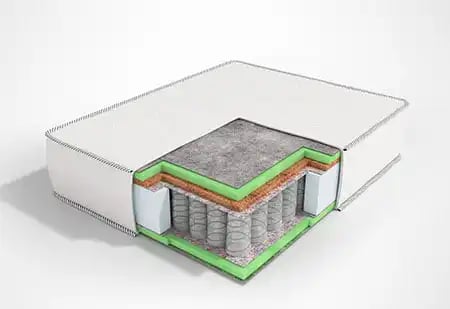 Our brains may be on snooze while we’re sleeping but our bodies are definitely not. Our muscles and skeletal system are engaged, our skin is exchanging moisture with the air around us, our heart is pumping away and our lungs keep the oxygen flowing in and out.
Our brains may be on snooze while we’re sleeping but our bodies are definitely not. Our muscles and skeletal system are engaged, our skin is exchanging moisture with the air around us, our heart is pumping away and our lungs keep the oxygen flowing in and out.
So, what lies beneath the surface of the medical and bedding fabrics we come into contact with during sleep is important. That’s why manufacturers expend so much effort at finding the right combination of materials to support us while we’re getting our zzzzs.
In institutional settings, getting sleep systems right is even more important to ensure patients, students, inmates, or residents are properly supported given their unique medical needs.
The Middle Layer
Mattresses come in three basic types: innerspring, foam and polyester, and air-supported. Each has its advantages depending on how they will be used.
In medical or nursing home environments where patients can be lying prone as much as 24 hours per day (and thus at risk of developing pressure ulcers, commonly known as bedsores), air-support mattresses are often the ideal solution.
From the most simple to the highly complex, air-supported mattresses have the advantage of being capable of modulating and adjusting the air pressure in the mattress. At its most basic functionality, they can provide more or less support to provide comfort based on a patient’s preference.
Some of the more-sophisticated air-supported mattresses can provide multiple pressure settings along the surface simultaneously and, using timers, automatically adjust settings on a prescribed basis according to a patient’s needs. These systems can also assist care providers in rotating bed-ridden patients to mitigate the onset of bedsores.
Polyester and foam mattresses also help reduce pressure on sensitive body parts and enable different support options for head, feet, and torso. The foam reduces pressure where needed and provides additional support where it is most effective.
Mattresses which rely on innersprings for support are perhaps the most common type of mattress (especially residential and in the hospitality industry). Springs of varying strength and resistance are especially useful when dealing with a heavier-weight population.
Ticking, Quilting, and Coils
The top layer of any mattress (known as the ticking) can be fashioned from any of several materials, including cotton, cotton-polyester blend, vinyl, or vinyl treated with antimicrobial properties which help mitigate the spread of harmful bacteria on the fabric surface.
Beneath the outermost layer of the mattress is the quilting or top pad layer. This layer attaches the ticking to the fire-resistant batting (required by law). It works in conjunction with the support system to support you and together, these components determine how comfortable the mattress will feel. The larger the quilt pattern, the deeper the cushiony feel. Smaller quilting patterns produce a “harder” feel.
When this layer is composed of memory foam, the foam conforms to your body as you rest on top of it. In settings where the mattress is a double, queen or king size, memory foam also helps isolate the movement of any individual on the bed from the other.
A secondary, middle layer of padding serves to aid in support while also helping to protect the springs from coming into direct contact with the other, more-sensitive layers of padding above and thus minimize wear and tear.
In innerspring-type mattresses coil count and design are often hyped as a reflection of quality. But, consumer rating agencies assert that coil design is of little consequence and even the least-expensive beds are likely to have sufficient coils to get the job done over the life of any mattress. More important, they say, is the gauge of the wire. Heavier-gauge coils provide more support, lower-gauge coils give mattresses a springier feel.
Equip Yourself
Proper mattress selection is crucial whether for personal or commercial usage. But, it takes on a greater sense of importance when that mattress is potentially in use 24 hours a day, is used by multiple people over a given period of time, or is part of the front line of health care giving. Then, it’s a piece of equipment which contributes to patient care, facilities management, and ultimately, the bottom line.
Develop a set of criteria based on your institution’s needs, then consult a professional to help you select the right combination of bedding fabrics and support systems to get the job done.
